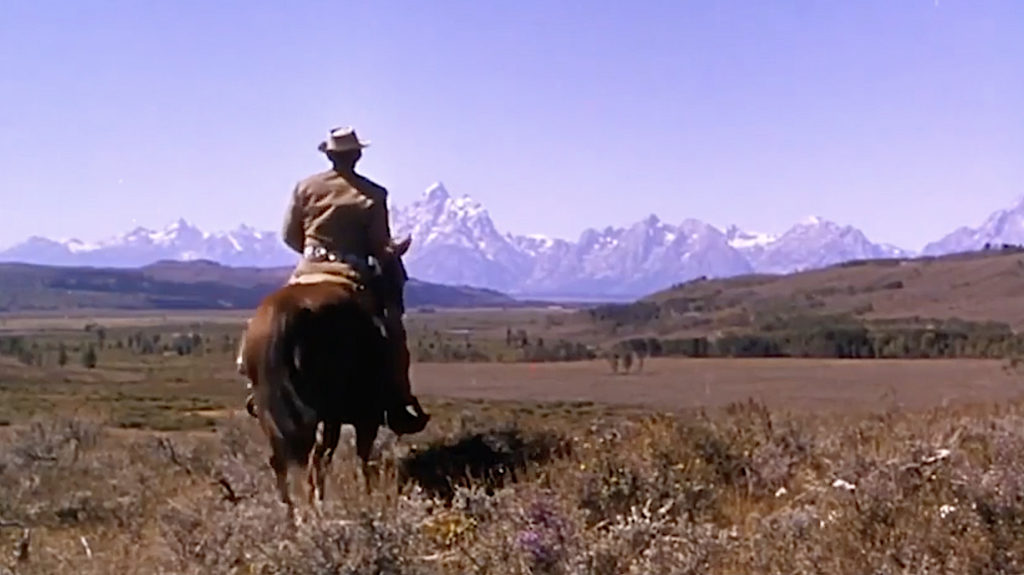Based on the 1949 novel by Jack Schaefer, and directed by George Stevens, the Western technicolor “Shane” (1953) is considered a masterpiece by many.
Seventy years on, the movie is still written about, analyzed, and taught in film courses.
Shane (Alan Ladd) is the quintessential outsider: no family, no history, a man of action, and very few words.
He appears at the top of a hill in the wild, wild West, silhouetted against the purple mountains of Wyoming. Loyal Griggs’ cinematography won him an Oscar, while Victor Young’s score speaks of the pioneer spirit, our longing for home, our love for the land.
Into the valley Shane rides, on his white horse, through the chaparral, across a stream, in a buff-colored suede fringed shirt.
The homestead below is owned by Joe Starrett (Van Heflin) and his wife, Marian (Jean Arthur).
“Somebody’s coming, Pa,” says young Joey (Brandon deWilde).
“Well … let him come.”
Shane is slight, blond, and wears an ivory-handled six-shooter he hangs on the back of his chair at supper and never puts on again till the final scene.
He’s headed north. Where? “One place or another. Some place I’ve never been.”
He stays on as a farmhand. The kid instantly idolizes Shane. So do we. So does Marian. Obviously, she and Shane are deeply attracted to each other, though their feelings are never discussed.
After a knock-down, drag-out fight at the local saloon in which Shane and Starrett, though outnumbered, win, she bathes his wounds, and offers to bandage him.
Afterward, son and mother peer through the slats of the bedroom wall for a glimpse of him.
“Don’t get to liking Shane too much,” Marian tells Joey, obviously talking to herself.
“Why not?” he pleads.
“He’ll be moving on one day, Joey.”
Interestingly for a movie with a major theme of manhood, neither Starrett nor Shane is an alpha male.
Starrett is stolid, steady, fair, the glue that binds the homesteaders together.
Shane is more charismatic, handsome, more cryptic: a better shot and as it turns out, a better fighter.
Starrett sees all of this, absorbs the hurt, trusts his wife — and Shane — implicitly, knows he is loved and valued, and goes on with his work.
The alpha male is Ryker, head of the dastardly posse bent on booting the hard-working homesteaders out of the valley. Coarse and conniving, he covets grazing land for his cattle.
Shane is small, compact, strong but not beefed out. The Rykers all but call him a sissy.
Joey sneaks into Shane’s room one day, finds his gun, runs his hands over it lovingly. “Shane!
Will you teach me how to shoot?” he begs.
The two go into the side yard. “You always have it here, with the grip between the elbow and the wrist. So when your hand comes up, the gun clears the holster without coming up too high, see?”
Marian hears a shot, comes out, and is upset. Shane gives an iconic speech. “A gun is a tool, no better or worse than any other tool, an ax, a shovel, or anything. A gun is as good or as bad as the man using it.”
“We’d all be better off if there wasn’t a single gun in this valley,” Marian replies, “including yours.”
The Ryker clan hires a professional gunslinger to come in and take the homesteaders out: Jack Palance, reptilian in a black hat.
There’s a shootout at the saloon. The kid sneaks down to watch from afar. The bad guys go down but Shane is wounded. We can’t tell how bad. “Shane! You’re bleeding!”
Shane, back on his horse, only smiles sadly. He tells Joey to grow up to be strong and straight, and to look after his parents. Then, his mission completed, he rides off into the sunset.
“Come back, Shane! Come back!”
“Mother wants you, I know she does!” The words echo across the plain but Shane — for whom there is no longer a place in the valley — only keeps riding.
Many people besides me have seen Shane as a kind of samurai, or medieval knight, or Christ figure. He’s in the world but not quite of it. He’s a sharpshooter who dislikes fighting. With no family himself, he is willing to die for a family. His calling is not primarily to kill, but to bear the terrible burden — the wound, the isolation, the exile — of killing.
The movie raises all kinds of questions: Is a gun really just a tool? When, if ever, is violence and even killing permissible for the follower of Christ? Did Shane die at the end?
One thing’s for sure: The director George Stevens, sickened by the brutalities he’d seen as head of the Signal Corps Special Motion Picture Unit in Europe during World War II, was in no way trying to glorify violence.
If anything, the message of the film is that to perpetrate violence, and especially to kill a man — no matter how justified the killing might seem to be — leaves an ineradicable mark on the soul.
“Come back, Shane!” cries Joey and he is really saying, “Come back, our childhoods!”
When everything was clear-cut.
When our idols were untarnished.
When someone else did the dirty work for us.
